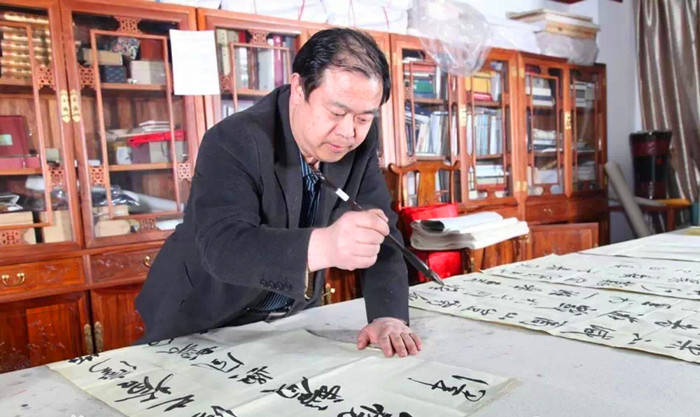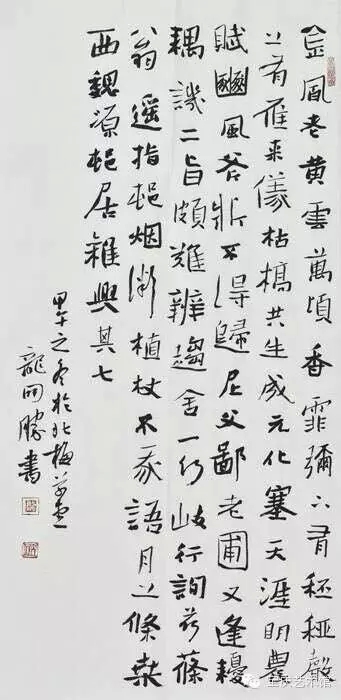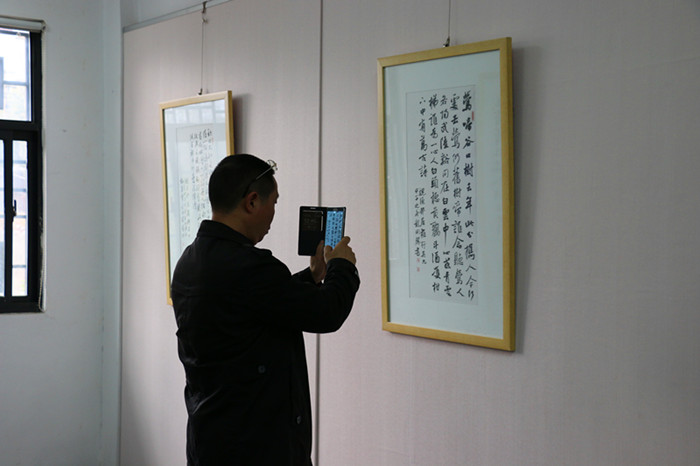Long Kaisheng’ s Calligraphic Works On Display At Baoqing Gallery
Source:Shaoyang International CultureWriter:Zeng ZhenghuaTime:2015-03-10Clicks:次

From February 16 to March 1, 2015, the New Year Exhibition of Long Kaisheng’ s Calligraphic Works of Wei Yuan’ s Poems took place at Baoqing Gallery. The exhibition was held jointly by Shaoyang Artists’ Union and Shaoyang Calligraphers’ Association. Long Kaisheng is a well-known military calligrapher, while Wei Yuan, the first man who opened his eyes to look at the world in Chinese history, was a celebrated thinker in China’ s modern history.

Long Kaisheng, with Mokan (meaning Naive Ink in Chinese) as his pen name, was born in Longhui County, Hunan Province, in August, 1969 and graduated from the Fine Arts Department of the Capital Normal University. He is now serving as an officer in the Artistic Creative Office of the Political Department Of the Air Force of the PLA. In addition, Long acts as a council member of China Calligraphers’ Association, deputy president of Beijing Calligraphers’ s Association, professor of the Training Center of China Calligraphers’ Association, member of the 10th China National Youth Union and judge of the Exhibition of the 4th Sector Calligraphy Exhibition.

Long Kaisheng, who grew up in the furnace of the Army, is simple and honest with the frankness, straightforwardness, acuteness and boldness of Xiang people. He is not only wise but also hardworking. His calligraphy originates from Wang Xizhi and Wang Xianzhi (two great calligraphers in the Jin Dynasty) with his own thoughts dissolved in, thus reflecting a modern aesthetic sense, but without losing traditional skills, classical and simple styles, graceful image and harmonious beauty. He is so particular about the law of calligraphy that his brushwork is stable and strong, and strokes and characters are well- organized.

It is a heated topic in the present calligraphic field how traditional skills are combined with the spirit of modern civilization and artistic conception. In the process of calligraphic creation, calligraphers without exception are trying their best to seek a dialectical integration of traditional laws and modern ideas no matter what type of script is written. Long Kaisheng is good at many types. He is good not only at writing the Two Wangs’ running hand but also at official script, regular script and script of Wei Dynasty Tablets. And he occasionally writes seal characters. Whatever type of script he writes is not ordinary but noble and elegant. He melts together in his works of official script the styles of Zhang Qian Tablet and Cao Quan Tablet in the Han Dynasty, while those of his regular script writing are of the style of the calligraphers in the Jin Dynasty with mainly square strokes. His calligraphy is perfect in brushwork, the structure of a character, ink skills and the organization of characters in a work. When watching him making calligraphic creation, one feels his brush moving like clouds flying and water running without a stop.

His achievements come certainly from his gift and comprehension, but more from his hard work. He will use up a large roll of paper in practice within a week, which goes on day by day and year after year whether in hot summer or in cold winter. It is common that he practices late into the night in most days. In this way he has accumulated his skills and laid the foundation of his calligraphy.

His calligraphic creations won him a number of honors and awards. He won the honors of the 5th National Chinese Personage Of Outstanding Ability, the 2006 China’ s Ten Best Calligraphers, the 2009 China’ s Ten Best Calligraphers, the 5th Beijing Middle-aged and Youth Artist Award in 2015, and so on. He was also granted many awards, such as the golden prize of the National TV Calligraphy Competition, the second prizes of the 2th and 3th China Lanting Calligraphy Award, the first prizes of the National Seal Cutting Exhibition, the National Xizhi Cup Calligraphy Competition and the 4th PLA Calligraphy Exhibition, ect.
(Translated by Yi Daoqun)
